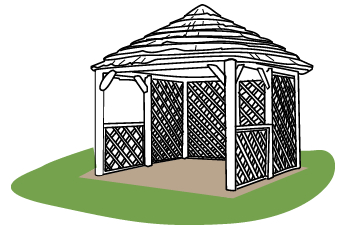
What is thatch roofing made from?
Thatch roofs for pergolas are typically made from closely bound dried reeds, such as the South African Cape Reed, which are attached to a thin strip of steel to make thatching tiles. Other materials like straw, willow branches, rushes and some species of grass can also constitute thatching material. These days thatching is normally made from a renewable resource, and is one of the greenest solutions to choose when selecting a roofing material.
What function does thatch pergola roofing serve?
Thatch roofing provides 100% UV protection, will block out most of the rain (depending on the thickness of the thatch) and also serves as a natural temperature regulator, insulating the space underneath and making it cooler during the day while trapping heat underneath it at night.
Thatch isn’t as flammable as it appears to be, especially if it's dampened, and it burns slowly if it's set alight. As a natural product it breathes, doesn’t break or crack, requires no maintenance and won’t allow water to condense making it ideal for use over spas and hot tubs where steam might otherwise be a problem.
How is thatch attached?
For reed tiles, the strips of reeds are clipped onto the battens and laid from the bottom up, forming a ridged roof look. Other methods include tying off bundles of thatching material and packing them closely together to seal any gaps while attaching them to the roof and, in rare cases, cross-hatching. For all thatched roofs it is necessary to have a roof with a reasonably high pitch to allow for proper drainage, so make sure your pergola is stable enough for this and check with your local council about height regulations if you're planning on adjusting an existing structure.
What variations exist?
There are a wide variety of thatching materials to choose from all over the globe. When selecting a material, consider how closely the environment the material was harvested in compares to the one you live in, as this can help you determine whether the material will be suitable.